I’ve been in the ecommerce business trenches for years, and let me tell you — email marketing isn’t just another channel, it’s basically your secret weapon. When I first saw that stat about email marketing generating $36 for every dollar spent, I was skeptical. But after implementing these strategies for dozens of clients, I’m a believer.
What is Ecommerce Email Marketing?
Ecommerce email marketing isn’t rocket science — it’s just sending targeted email campaigns to people who’ve shown interest in what you sell. The beauty? Unlike dumping money into Facebook ads that disappear the minute you stop paying, email marketing is something you own.
Think about it — you’re building direct relationships with:
- Potential customers curious about your products
- Shoppers who abandoned their carts (we’ve all been there!)
- Existing customers who might buy again
- Loyal customers who could become advocates
What makes email marketing for ecommerce special? You actually own these relationships. Unlike other marketing channels where you’re essentially renting attention (and paying more each year!), your email subscribers belong to you.
I love explaining to my clients that email marketing is like having your own media channel where you control the marketing messages completely. No algorithm changes, no sudden cost increases — just direct access to people who’ve already shown interest in what your online store sells.
Benefits of Ecommerce Email Marketing
I’ve been running email marketing campaigns for years now, and I’ll tell you this — nothing beats email when it comes to bang for your buck. While my clients keep watching their Facebook ad costs creep up every quarter, their email marketing efforts just keep delivering.
It’s like having a direct line to your customers without Mark Zuckerberg or Google standing in the middle with their hand out. When you build your email marketing strategy right, it becomes the backbone of your entire ecommerce marketing approach.
- Ridiculous return on investment. I’ve seen firsthand how ecommerce email consistently delivers $38-$42 back for every dollar spent. No other marketing channels come close! One of my apparel clients shifted budget from paid social to email campaigns last year and saw their marketing ROI jump 27% while spending less overall.
- Building customer relationships. Email lets you talk to customers between purchases, not just when you want their money. My most successful clients use email marketing to share their brand story, offer genuine value, and acknowledge customer milestones. turning occasional shoppers into loyal customers who recommend them to friends.
- Automation that doesn’t feel robotic. Modern email marketing tools let you set up these incredibly smart behavioral triggers. One beauty brand I work with implemented a post-purchase emails sequence that automatically adapts based on what people bought, when they open emails, and even what they click on. The result? Their repeat customers rate jumped 23%.
- Rescuing abandoned carts. We’ve all done it — added something to cart and then gotten distracted. A well-crafted recovery sequence can bring 10-15% of those people back! My favorite approach uses a three-email sequence that starts helpful, addresses objections in email two, and only offers a discount code in the final message.
- Increasing customer lifetime value. Instead of constantly chasing new customers (expensive!), email marketing helps extend relationships with existing customers. I’ve implemented replenishment reminders for consumable products that have boosted retention rates by double-digits.
- Marketing that works at every stage. Email campaigns aren’t just for promotional messages. They work throughout the entire customer lifecycle. from welcome sequences for new subscribers to educational content to promotional offers to post-purchase support to re-engagement emails for lapsed customers.
- Seeing exactly what works. Unlike trying to figure out if your billboard or TV ad actually drove website traffic, email marketing performance shows you precisely who opened, clicked, and purchased. One of my clients finally stopped arguing about marketing budget when we could show exactly how much revenue each campaign generated.
- Nobody can take your list away. Remember when Facebook organic reach plummeted overnight? Or when Instagram changed their algorithm? Email marketing doesn’t have those problems. Your list is YOURS, and no platform changes can come between you and your interested customers. That stability is incredibly valuable in today’s constantly changing digital landscape.
3 Core Categories of Ecommerce Emails
I’ve been managing email marketing campaigns for online businesses for over a decade now, and I’ve found that breaking down your email marketing strategy into three distinct categories makes the whole process way more manageable.
Each category serves a different purpose in your customer lifecycle, and when they work together? That’s when the magic happens.
After auditing hundreds of ecommerce store accounts, I’ve seen how these categories aren’t just separate tactics – they’re interconnected parts of the customer experience. Let’s dive into how these ecommerce email campaigns work together to drive both immediate more sales and long-term loyalty.
Transactional Emails
I can’t stress this enough — your transactional emails are absolute gold mines for engagement. We regularly see open rates hitting 60-80% with these, which blows promotional emails out of the water (they typically hover around 15-25% if you’re lucky).
What makes these so powerful? They arrive precisely when customers are experiencing that nervous “did my order go through?” moment. You know that feeling after you’ve clicked “purchase” and you’re waiting for confirmation emails? That’s prime real estate for building trust.
Key characteristics:
- They trigger automatically after specific customer purchases;
- They’re primarily informational rather than sales-focused (though you can sprinkle in recommendations);
- They represent crucial touchpoints where customers form opinions about your brand story;
- They contain those legally required bits about purchases;
- They create branded emails with natural openings for gentle cross-selling without being pushy.
Prime examples include:
- Order confirmation. These hit inboxes immediately after purchase, reassuring customers their money didn’t just disappear into the void. They also cut down on those “where’s my stuff?” support tickets by clearly stating product details, pricing, and expected delivery date.
- Shipping notifications. Nothing builds excitement like tracking info! These automated emails keep customers engaged during the wait, provide realistic delivery estimates, and offer the perfect opportunity to suggest product care tips or complementary items they might’ve missed.
- Password reset communications. Nobody plans to forget their password, but when they do, your speedy response demonstrates you value their security. Clear instructions and reassuring language about account protection go a long way here.
- Thank you emails. These simple acknowledgments can transform transactional relationships into emotional connections. I’ve seen ecommerce brands use these to highlight loyalty program updates or include small “we appreciate you” perks that encourage customers to make future purchases.
Promotional Emails
Let’s be real — these revenue-drivers form the backbone of most email marketing programs. Unlike transactional emails that customers actively expect, promotional emails need to work harder for attention. The days of “spray and pray” batch blasting are (thankfully) behind us.
I’ve analyzed countless promotional messages, and the difference between mediocre and exceptional results almost always comes down to segmentation. When you target based on purchase history, browsing behavior, and engagement patterns, you’ll consistently outperform generic sends.
Key characteristics:
- You send these proactively based on your marketing calendar;
- They require thoughtful planning around timing, frequency, and audience targeting;
- The best ones balance promotional content with genuine value;
- They need compelling subject lines that cut through inbox clutter;
- They should feature clear, action-oriented messaging that drives clicks;
Most effective types include:
- Product launches. There’s nothing like the buzz of something new! The best launch emails I’ve seen tell compelling brand story elements, offer special introductory pricing, and create that “exclusive early-access” feeling that makes email subscribers feel like VIPs.
- Seasonal campaigns. Timing is everything with these. Whether it’s Black Friday madness or summer vacation season, these emails should feature thematic designs that stand out, carefully curated product collections, and time-sensitive deals that align with what customers actually need during that season.
- Limited-time offers. The psychology of urgency is powerful, but you’ve got to be authentic about it. Clear deadlines, tasteful countdown timers, and honest inventory scarcity messaging tap into FOMO without feeling manipulative. I’ve seen conversion rates double with well-executed urgency campaigns.
- Store-wide sales. These broader promotions highlight discounts across multiple categories, often using tiered structures (spend $100, save 15%; spend $150, save 20%) to boost average order values. They’re particularly effective for clearing seasonal inventory without sacrificing margins.
- Newsletters. The unsung heroes of email marketing! These relationship-builders blend content marketing, company updates, and product showcases in a value-first approach. The ecommerce brands that do this well position products contextually within interesting content rather than making every newsletter a sales pitch.
Lifecycle (Automated/Behavioral) Emails
This is where email marketing truly shines. responding to specific customer behaviors with perfectly timed, relevant messages. After implementing comprehensive lifecycle programs for dozens of brands, I’ve seen these generate 3-5x higher engagement rates than standard promotional campaigns.
The beauty of these? Once set up properly, these automated emails operate continuously in the background, delivering exactly what customers need precisely when they need it. These create those “how did they know?” moments that feel remarkably personal despite being automated.
Key characteristics:
- They trigger based on specific behaviors or time-based milestones;
- They’re hyper-personalized using customer data;
- They work 24/7 once properly configured (though they need regular refreshes);
- They deliver contextually relevant messages at just the right moment;
- They gradually build deeper customer relationships over time.
Essential automated sequences include:
- Welcome emails. You never get a second chance at a first impression! The most effective welcome sequences I’ve implemented introduce the brand story over 3-5 emails, establish what communications to expect, and often include progressively better offers if earlier emails don’t convert. Some of my clients see 35%+ conversion rates from these sequences.
- Abandoned cart emails. The bread and butter of ecommerce email marketing! These recovery-focused sequences remind shoppers about products left behind, address common objections (“free shipping?”), showcase social proof, and typically include incentives that increase in value across 2-3 messages. One apparel client recovers nearly 18% of abandoned carts this way.
- Browse abandonment. These gentler reminder messages acknowledge products viewed but not carted. I’ve found they work best when they include related recommendations, helpful comparison guides, and subtle availability messaging. They’re less pushy than cart abandonment but still remarkably effective.
- Post-purchase emails. The purchase isn’t the end — it’s the beginning! Smart ecommerce brands send usage tips, styling ideas, maintenance instructions, and thoughtful cross-sells timed to arrive after delivery. I’ve seen these not only boost customer satisfaction but generate substantial additional revenue through accessories and complementary products.
Deep Dive: Must-Have Ecommerce Email Types
I’ve been managing ecommerce email marketing strategies for about a decade now, and if there’s one thing I’ve learned, it’s that having a structured approach makes all the difference. Let me walk you through the email types that consistently deliver results for my clients.
Rather than seeing these as separate campaigns, I’ve found success by viewing them as connected touchpoints in the customer lifecycle. Each serves a specific purpose while contributing to your bigger business goals. Let’s break down what actually works in the real world.
Welcome Emails
I can’t stress this enough — welcome emails are absolute gold mines. They consistently generate 320% more revenue than standard promotional messages for my clients. First impressions matter tremendously in establishing your brand relationship.
I’ve tested countless welcome sequences, and the data clearly shows that a series of 3-5 emails outperforms a single message by about 51% in revenue. One beauty client of mine saw a significant improvement in their welcome sequence conversion rate after we switched from a single message to a three-email approach.
The results were quite dramatic and showed how effective a properly segmented welcome series can be compared to a one-time introduction.

What works in practice:
- Send that first email immediately after a visitor subscribes: I’ve seen engagement drop by 40% when delayed even an hour;
- Don’t just use their name: acknowledge how they found you and what they’ve shown interest in;
- Be crystal clear about what emails they’ll receive and how often (this reduces unsubscribes later);
- Include an offer with a reasonable deadline: 24-48 hours creates just enough urgency without feeling pushy;
- Tell your brand story briefly: I’ve found 2-3 sentences works better than lengthy paragraphs;
- Mobile optimization isn’t optional: over 60% of welcome emails get opened on mobile devices, at least for my clients.
With Sender, email marketing is simple, quick, and affordable. Do everything from capturing leads to nurturing them within one dashboard – no design or tech skills required.
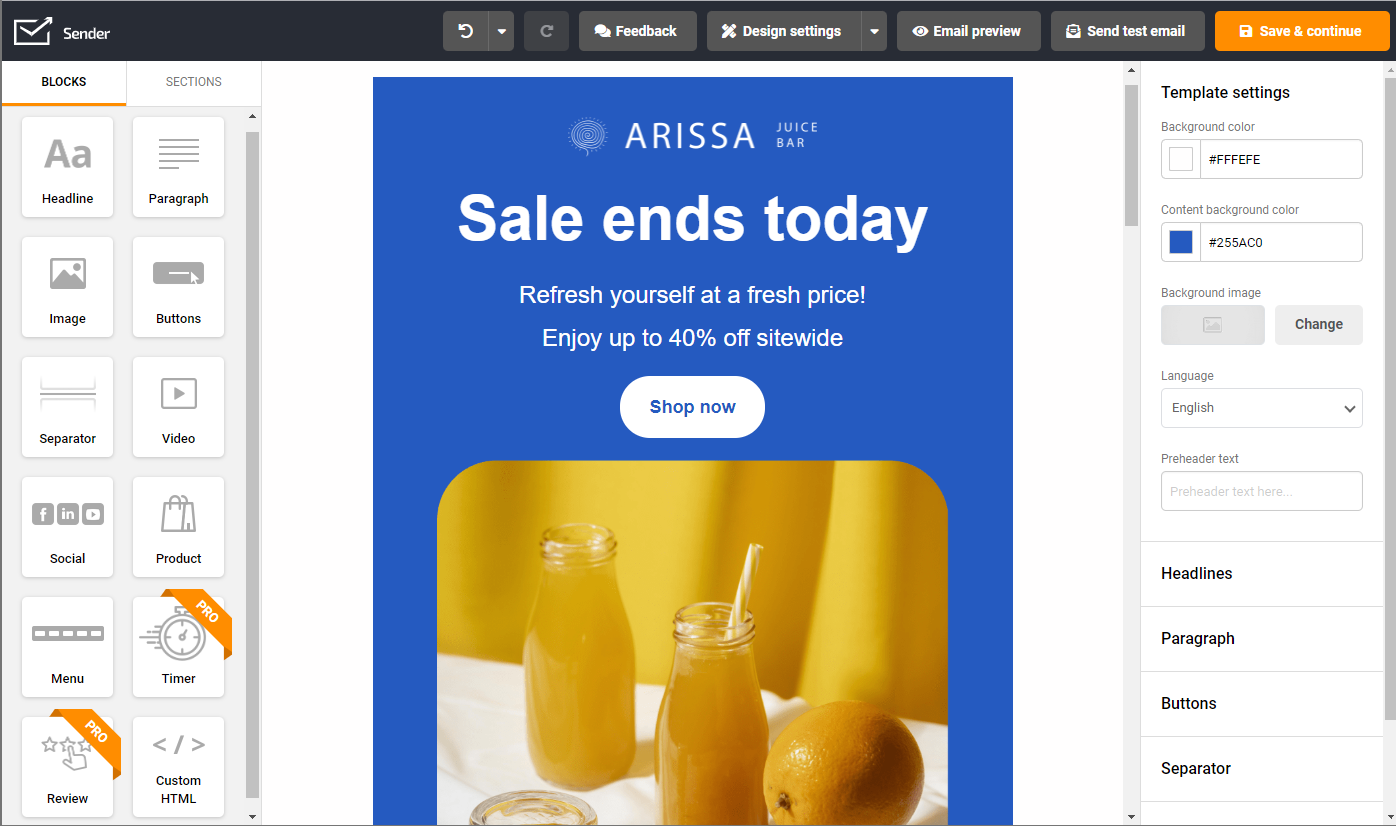
Abandoned Cart Emails
Cart abandonment is just a reality of ecommerce – averaging around 70% across industries. The good news? A solid recovery sequence can reclaim 10-15% of those potential lost sales. For one of my apparel clients, that translated to an additional $27K monthly.
I’ve tested countless approaches here, and a three-email sequence typically recovers 69% more revenue than a single reminder. The psychology behind this is fascinating – different people respond to different approaches and timings.
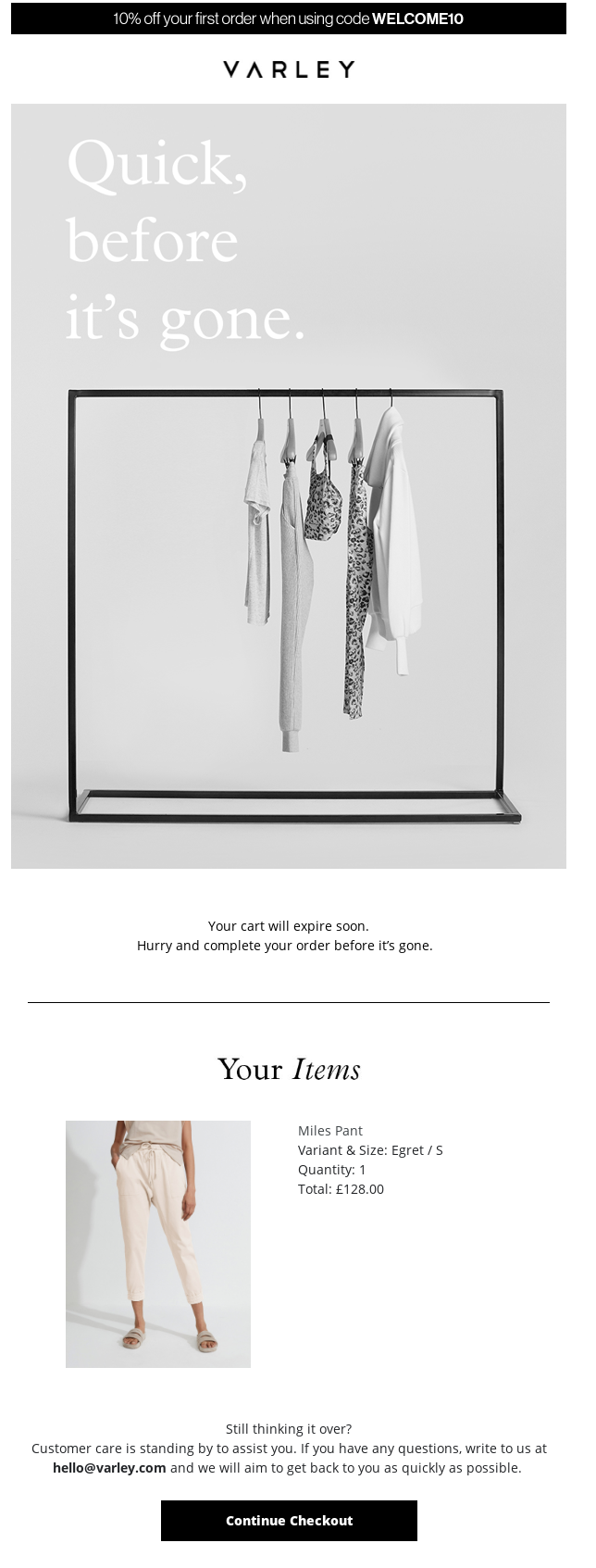
What actually works:
- That first reminder needs to go out quickly: 1-3 hours after abandonment shows dramatically better results than waiting a full day;
- Include clear product images and details: you’d be surprised how many people simply forgot what they were considering;
- Address common objections directly: for one client, simply adding “Free Returns” to the subject line improved conversion by 15%;
- Social proof works wonders: adding customer feedback to cart emails boosted conversion by 11% for my home goods client;
- Test different incentives: I’ve found percentage discount codes work better for higher-priced items, while free shipping often wins for lower-priced goods;
- Progressive urgency seems to be the sweet spot: helpful reminder first, gentle urgency second, stronger offer in the final email.
Order & Shipping Confirmation Emails
Here’s a missed opportunity I see constantly — treating these confirmation emails as pure utility rather than marketing touchpoints. These messages see 60-70% open rates (incredible!), yet many ecommerce brands use generic, boring email templates.
What’s particularly interesting is that transactional emails containing relevant product recommendations generate 20% higher transaction rates than purely functional ones. I call these “utility-plus” emails — they satisfy the customer’s need for information while subtly encouraging further engagement.

Real-world best practices:
- Keep your branding consistent: I’ve worked with clients whose confirmation emails looked completely different from their ecommerce site, creating disconnect;
- Include all order details with product images: this reduces “where’s my stuff” support tickets dramatically;
- Make tracking information super obvious: it should be the easiest thing to find in shipping confirmations;
- Add actual value: one electronics client includes quick setup tips in their confirmations and saw support inquiries drop by 17%;
- Cross-sell subtly: recommendations based on previous purchases convert at 3-5x the rate of generic “you might also like” suggestions;
- Use shipping confirmations to build anticipation: one fashion client includes styling ideas in these emails with great results.
Product Recommendation Emails
The numbers don’t lie — personalized email campaigns see 26% higher open rates and 41% higher click rates than generic promotional blasts. When done right, these feel helpful rather than pushy.
I’ve experimented with various recommendation engines over the years, and the most effective ones combine multiple data sources — what customers bought, browsed, wishlisted, plus what similar customers purchased. This creates suggestions that genuinely resonate with your most valuable customers.

Tactics that actually work:
- Segment your recommendations based on customer value: your approach should differ for one-time vs. repeat customers;
- Personalized messages in subject lines make a huge difference: “Selected for you based on your recent purchase” outperforms “You might like these” consistently;
- High-quality product images are non-negotiable: one client saw click rates double after improving their product photography;
- Context matters enormously: explaining WHY you’re recommending something (“Because you purchased X”) creates transparency that customers appreciate;
- Balance complementary items with discovery: accessories for previous purchases work well, but also introducing new categories can expand customer lifetime value;
- Different algorithms work for different catalogs: what works for fashion often flops for electronics, so continuous testing is essential.
Re-engagement Emails
List decay is inevitable — on average, email databases deteriorate by about 22% yearly. The good news is that well-crafted re-engagement emails can recover 5-15% of inactive subscribers. Considering new customer acquisition costs 5-25x more than retention, these campaigns deliver serious ROI.
I’ve found that effective win-back sequences acknowledge the absence without being creepy about it, remind customers why they liked you in the first place, and offer a compelling reason to return to your online store.
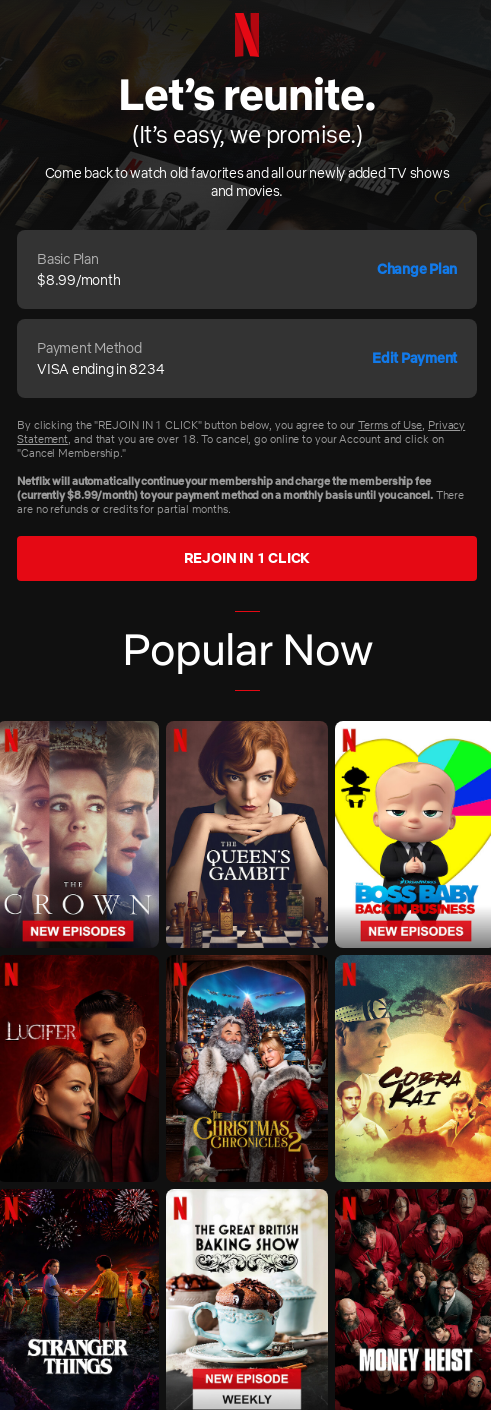
Approaches that deliver results:
- Define “inactive” based on your typical purchase cycle. 3 months might be alarming for a grocery delivery service but totally normal for a furniture retailer;
- Subject lines need to grab attention. “We miss you” still works surprisingly well, though “Is this goodbye?” creates even more urgency;
- Authenticity matters in your marketing messages. Overly sales-y tones tend to fall flat in these campaigns;
- Test different incentives. Sometimes a straightforward discount code works best, other times exclusive access to new products performs better;
- Give options to adjust preferences. One client reduced unsubscribes by 23% by including a simple “receive fewer emails” option;
- Have a plan for non-responders. Continuing to email people who never engage hurts deliverability for everyone else.
Newsletter or Promotional Emails
Regular newsletters keep your brand present between purchases and drive consistent revenue through discovery. Unlike purely promotional messages, the newsletters that perform best for my clients balance value (about 80%) with subtle promotion (about 20%).
I’ve helped dozens of ecommerce brands develop strategic newsletter calendars that align with seasonal opportunities and customer interests. The most successful establish a consistent rhythm while continuously testing content approaches.
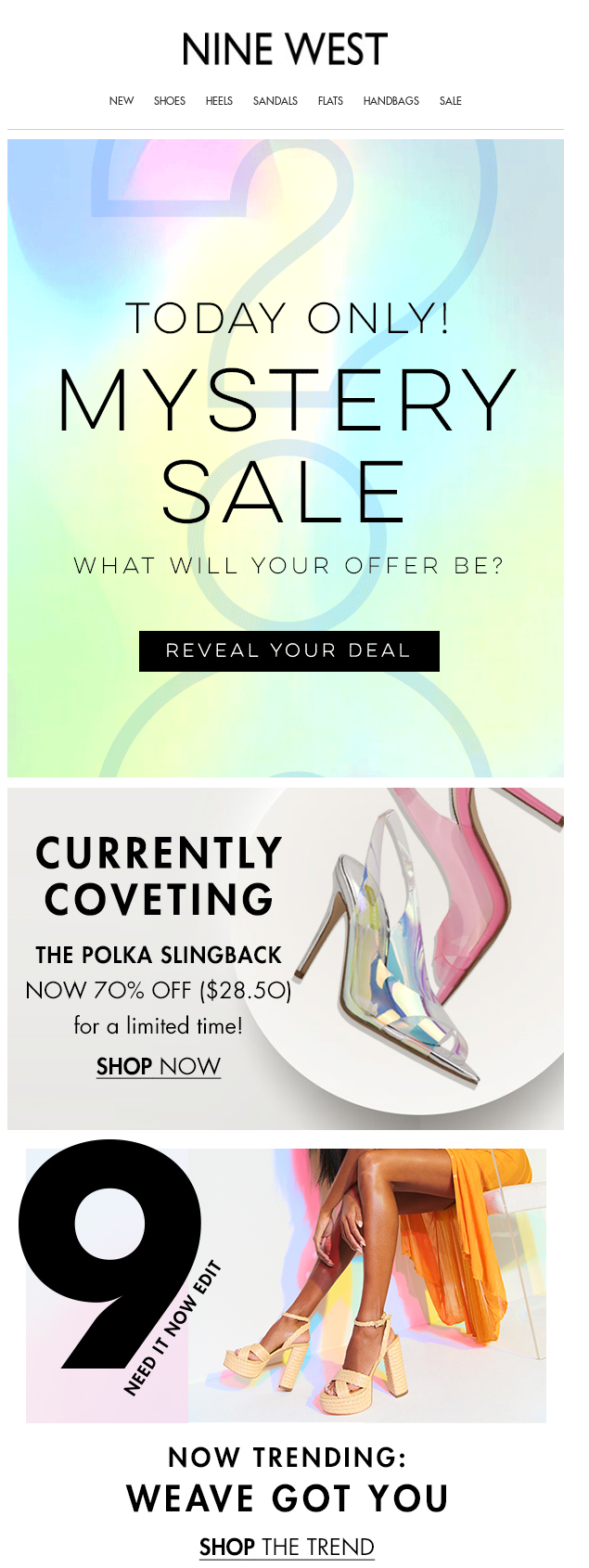
What separates great newsletters from spam:
- Develop a recognizable template: when email subscribers instantly recognize your style, open rates improve;
- Segmentation makes a massive difference: one client saw revenue per email triple after we split their newsletter into three versions for different customer types;
- Content mix is crucial: educational content marketing, company updates, and product showcases need to work together;
- Subject line testing is non-negotiable: I’ve seen open rates vary by 15-20% based solely on subject line approaches;
- Create genuine urgency when appropriate: limited inventory or truly time-sensitive deals perform well, but fake urgency backfires;
- Find your ideal content-to-promotion ratio through testing: what works varies dramatically by industry and audience;
- Interactive elements boost engagement: one client’s click rates improved 17% after adding simple polls to newsletters.
Birthday & Special Occasion Emails
The numbers here are staggering — birthday emails generate 342% higher revenue per email than standard promotions, with transaction rates 5x higher than normal campaigns. They create emotional connections that purely transactional messages simply can’t match.
Beyond birthdays, I’ve had great success with anniversary campaigns celebrating signup or first purchase dates. These provide another personalized touchpoint without requiring additional customer data collection.

Implementation that works:
- Collect birth month/day during signup: but make it optional to reduce form abandonment;
- Send birthday messages slightly before the actual date: this gives valuable customers time to use offers during their celebration;
- Make the offer genuinely special: standard 10% discount codes feel underwhelming for birthdays;
- Personalized messages should go beyond just mentioning the occasion: referencing previous purchases or interactions adds depth;
- Extend the validity period: 7-14 days accommodates people’s varying celebration timelines;
- Consider product “birthdays” too: one of our clients celebrates product launch anniversaries with special editions and sees tremendous engagement;
- Test sending time: morning vs. evening can significantly impact results depending on your audience and whether they check email on mobile devices or desktops.
Review/Feedback Request Emails
Products with reviews convert at rates 270% higher than those without, making customer feedback emails incredibly valuable. Well-designed review request emails dramatically increase submission rates while providing both social proof and product feedback.
I’ve found that making the review process ridiculously simple while acknowledging the customer’s time investment is key. Timing these requests appropriately—after sufficient product usage but before enthusiasm fades—significantly impacts response rates.
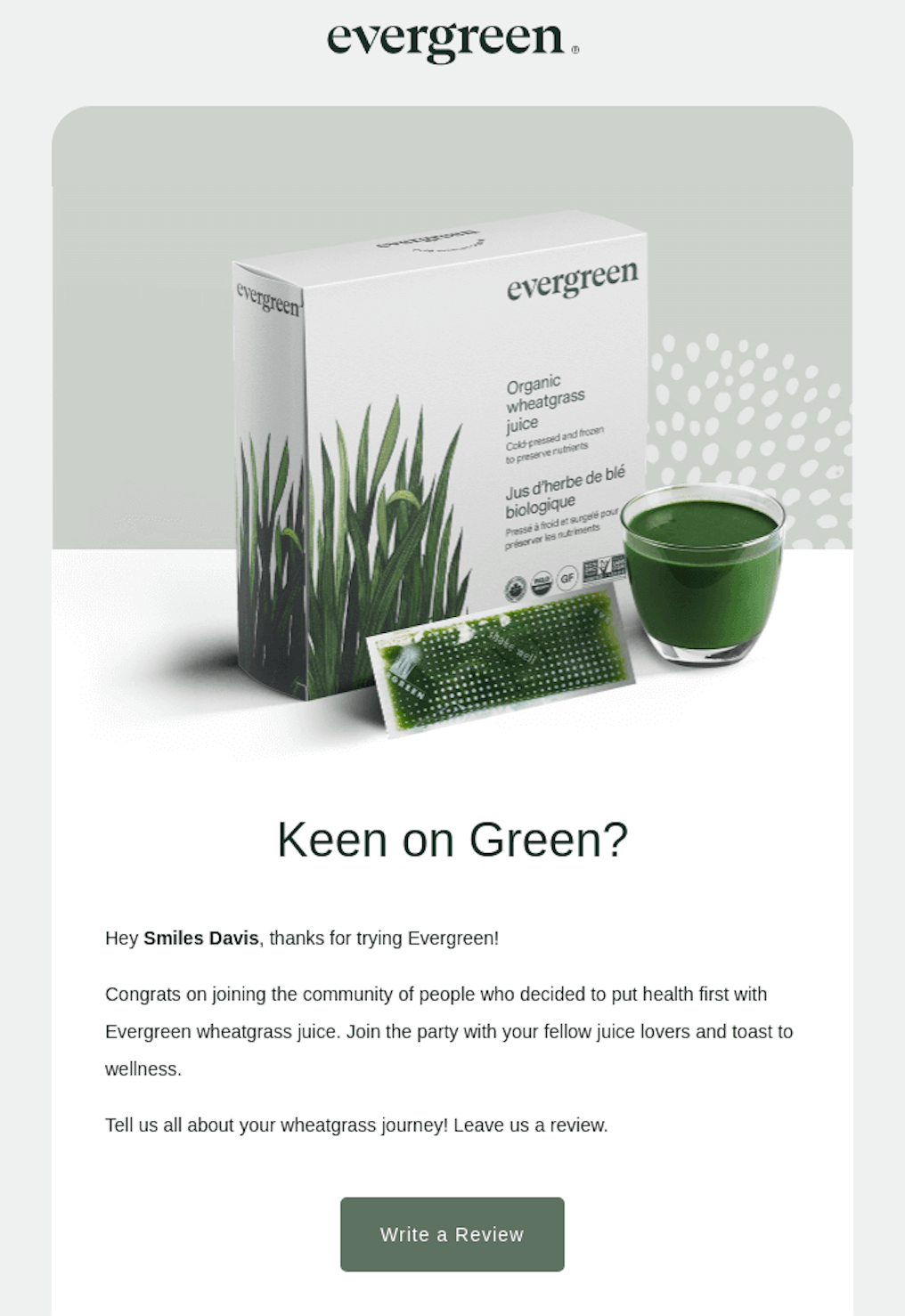
Approaches that generate actual reviews:
- Time requests based on the product: asking for customer feedback on furniture 2 days after delivery is too soon, but waiting 2 weeks for feedback on a t-shirt is too late;
- Include clear product images and order details: this eliminates confusion about what you’re asking about;
- One-click access to the review form is essential: every additional step reduces completion rates by roughly 50%;
- Be honest about the time required: “Takes less than 2 minutes” works well if that’s actually true;
- Small incentives can work wonders: one client offers loyalty points for detailed reviews and saw submission rates triple;
- A single follow-up reminder to non-responders is the sweet spot: more than that feels pushy;
- Responding to reviews completes the circle: one client publicly replies to reviews and has seen customer loyalty improve by 14%.
Referral Program Emails
The data on referred customers is compelling — they have 37% higher retention rates and cost 18% less to acquire than customers from other marketing channels. Effective referral programs transform satisfied customers into advocates through well-designed incentives and easy sharing.
I’ve found that the most successful referral programs create balanced rewards that benefit both the referrer and the new customer, fostering mutual benefit rather than purely transactional motivation.
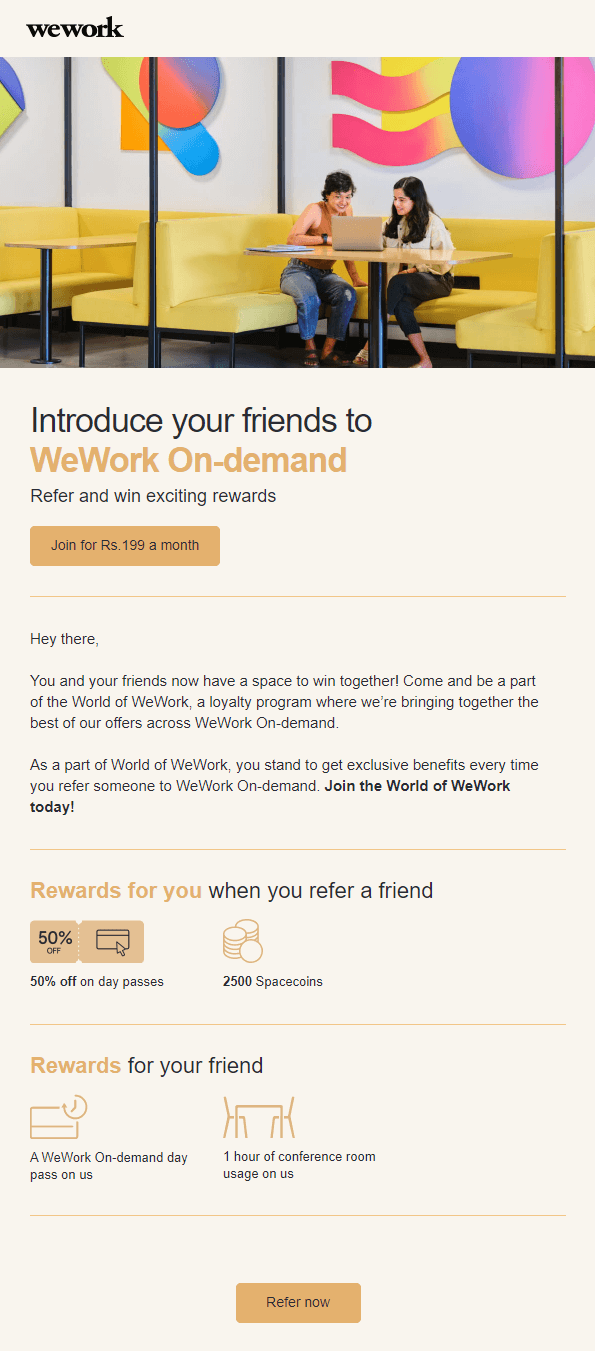
What actually drives referrals:
- Dual-sided incentives consistently outperform one-sided rewards — both parties should benefit;
- Sharing mechanisms must be dead simple: pre-populated messages with personalized notes work extraordinarily well;
- Clear explanation of how the referral program works prevents confusion — visuals often communicate this better than text;
- Visual presentation of potential rewards increases participation. One client saw referrals jump 22% after redesigning how they displayed the offer;
- Tiered rewards for multiple referrals can transform casual sharing into active advocacy;
- Acknowledging successful referrals is often overlooked — one client sends thank you notes and saw repeat referrals increase dramatically;
- Strategic placement throughout the customer lifecycle matters: post-purchase is obvious, but I’ve had success with referral prompts in shipping confirmations too.
Creating Your Ecommerce Email Marketing Strategy
When implemented thoughtfully, these email types create a communication framework that supports customers throughout their relationship with your brand. Each type serves specific needs while contributing to your broader marketing channels goals.
The magic happens when they work together to create cohesive experiences that naturally build customer loyalty and drive revenue.
The most successful email marketing programs I’ve built share a few key characteristics:
- They start with the fundamentals – welcome, transactional, and abandoned cart emails
- They measure email marketing performance rigorously, testing and optimizing continuously
- They evolve based on customer feedback and behavior
- They maintain a consistent brand story while adapting to different contexts
- They focus on value exchange, not just promotional messaging
Remember that email marketing for ecommerce isn’t a set-it-and-forget-it channel. The platforms, customer expectations, and best practices evolve constantly.
But the core principle remains the same: deliver relevant messages to the right people at the right time, and you’ll see results that no other marketing channels can match.



